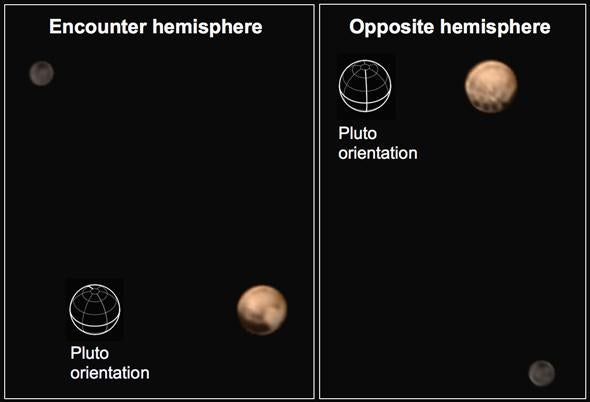Seriously, Pluto, what the heck are you up to?
As New Horizons gets closer every day, more details on the tiny world come into view. The latest? A very weird set of four similar dark streaks on the surface, stretching for hundreds of kilometers, and fairly evenly spaced.

Photo by NASA/Johns Hopkins University Applied Physics Laboratory/Southwest Research Institute
What the WHAT.
Those streaks are really too small to say much about them just yet. Although seen on older images blurred together due to low resolution, they only appear individually on images from Saturday, when New Horizons was close enough to see them and Pluto had rotated them into view (grayscale pictures from the long range camera were combined with lower resolution natural color images from another camera called, seriously, Ralph). The probe is only taking a few pictures per day as it approaches, trying to keep data storage to a minimum to save bandwidth for the big show coming in just over 11 days now.
It’s possible they’re multiple impact sites, but that seems really unlikely. They’re so evenly spaced… they’re also located very near the equator, and on the hemisphere pointed toward Pluto’s moon Charon. There’s been some suspicion that Pluto might be geologically active, spewing out jets of some material. Neptune’s moon Triton has dark geyserlike plumes, probably nitrogen from under the surface mixed with dust or some other dark substance.
Also, Triton (like Pluto) is a Kuiper Belt Object, an icy and rocky body from the outer solar system, captured by Neptune. Hmmmm.
What could drive such activity on Pluto? On Earth (or rather, under it) it’s the hot mantle moving under the continental plates that causes our tectonic activity. For Io’s volcanoes and the geysers of Enceladus (moons of Jupiter and Saturn) it’s tides from their parent planets.
Pluto and Charon are locked in both orbit and spin, so the tidal forces should all be balanced … now. However, it’s thought that Charon may have formed after a big impact on Pluto, blasting material into orbit that coalesced to form the moon. For some time after that event there would have been considerable tidal stress on Pluto, and the jets may have been active back then, leaving their marks on the surface.
The same is true for Charon as well, and the tides on it would be 10 times larger (since Pluto has 10 times the mass of Charon). Note that Charon is a lot darker than Pluto. Did it have even more activity than its big brother?
With close encounter just a week and a half away, we’ll be getting more amazing pictures every day. Unfortunately, New Horizons will be dipping low over Pluto’s opposite hemisphere from these weird features, so we won’t get super close-ups of them. But we’ll certainly get some better shots over the next few days.
This is getting so exciting! Stay tuned.
Update, July 2, 2015: I originally said the streaks were only seen in the June 27 data, but I meant that they were only seen individually after then. Also, the probe is taking only a few pictures to save bandwidth, not data storage as I originally said. It takes a long time to send back each image. After closest encounter we’ll be receiving images for many months.